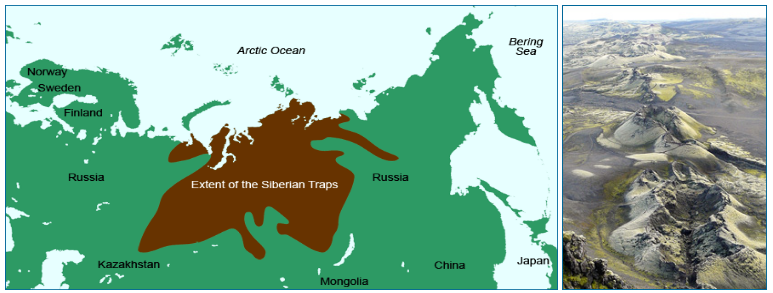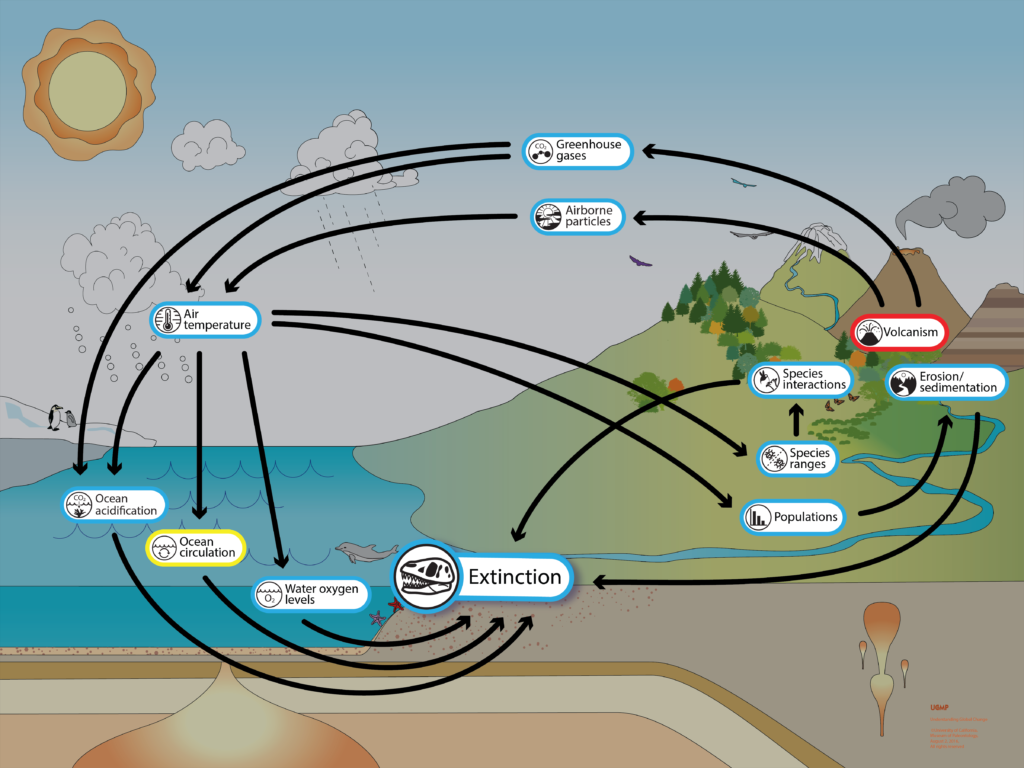Volcanic activity is now thought to be an important cause of several mass extinctions, but it may not be obvious exactly how this could trigger extinction on a global scale. After all, volcanoes like Vesuvius and Krakatoa were destructive, but didn’t cause mass extinctions. These sort of explosive eruptions are the kind that we are most familiar with, but in fact, they can’t happen on a large enough scale to cause a mass extinction. The sort of volcanic activity that scientists suspect leads to mass extinctions is not your iconic mountain erupting in a spew of lava. Imagine instead massive fissures and vents in the earth that ooze steady pulses of lava over hundreds of thousands of years. This sort of volcanic activity may not be as sensational as a top blown off a volcano, but it generates much more lava and affects vast areas, covering millions of square kilometers with lava, the bulk of which is released in a geologic instant — less than a few hundred thousand years. For example, the eruptions associated with the end-Permian extinction (the Siberian Traps) left behind lava that covers an area the size of Western Europe and is more than a kilometer thick!

This type of slower, oozing volcanic activity seems to cause extinctions through secondary effects, not through the eruption itself. Although oozing eruptions do directly release gasses that poison animals and plants and contribute to acid rain and climate change, the real catastrophe is likely caused by the rock layers that the lava comes into contact with as it erupts.8 If hot lava comes into contact with rocks that contain organic compounds (e.g., coal deposits) as it erupts, this releases huge amounts of greenhouse and toxic gases, like carbon dioxide, methane, and sulfur dioxide.
The chain of events set off by such shifts in atmospheric chemistry could have been disastrous. Large amounts of sulfur dioxide lead to short-term cooling (on the scale of tens of years), while carbon dioxide and methane then cause long-term global warming (lasting hundreds of thousands of years).8 These climate changes may directly lead to the extinction of sensitive species and prompt others to shift their ranges, upsetting ecosystem dynamics and triggering additional extinctions. Furthermore, if many land plants die, this increases erosion and damages delicate marine environments as sediments are carried into the ocean. Global warming also has the potential to reduce circulation of water in the ocean. When combined with the fact that oxygen doesn’t dissolve as well in warmer waters, this could lead to oceanic oxygen levels too low to support some species and could severely interrupt the flow of nutrients through the marine food web. To make matters worse for marine life, an increase in carbon dioxide in the atmosphere also acidifies the ocean, which prevents corals from building reefs and disrupts marine ecosystems from the bottom up. Large-scale volcanic activity could impact organisms and their habitats at many different levels, ultimately leading to skyrocketing extinction rates.

Learn more about volcanism on the Understanding Global Change site.
8Ganino, C., and N.T. Arndt. 2009. Climate changes caused by degassing of sediments during the emplacement of large igneous provinces. Geology 37:323-326.
Sobolev, S.V., A.V. Sobolev, D.V. Kuzmin, N.A. Krivolutskaya, A.G. Petrunin, N.T. Arndt, … and Y.R. Vasiliev. 2011. Linking mantle plumes, large igneous provinces and environmental catastrophes. Nature 477:312-316.
9Wignall, P.B. 2001. Large igneous provinces and mass extinctions. Earth-Science Reviews 53:1-33.
